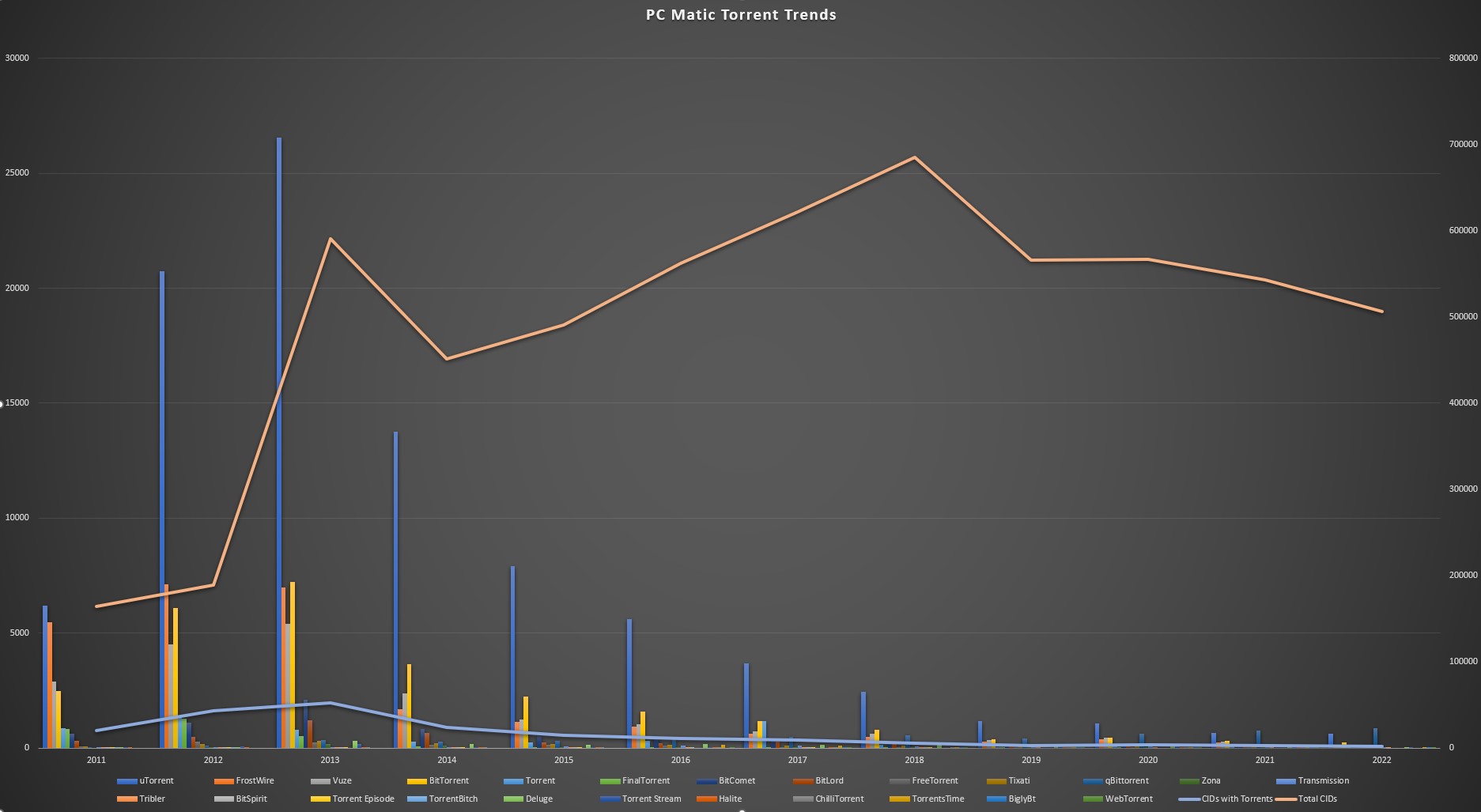The use of torrents has been a hot topic of debate for years, with some arguing that it’s a tool for piracy, while others defend it as a way to share large files. In this blog post, we’ll be analyzing the use of torrents by year, looking at how the trend has evolved over the past decade.
Before we dive into the analysis, let’s define what torrents are. Torrents are a peer-to-peer (P2P) file sharing protocol that allows users to distribute and download large files quickly and efficiently. Instead of downloading a file from a single server, the file is divided into smaller pieces and distributed across a network of users, with each user sharing the parts they have already downloaded.
Now, let’s take a look at how the use of torrents has evolved over the years.

A clear trend emerges after 2013 where we see a steep decline in torrent client usage. I hypothesize that this is due to the rise of inexpensive media streaming services. In 2023 people are just not downloading and storing large amounts of video on their devices. The convenience of streaming movies, tv, and music in high quality has nearly eliminated the need to keep space hogging files on personal devices.
2010-2013: The Golden Age of Torrenting
According to data from Google Trends, the popularity of torrents peaked in 2012 and has been declining ever since. In 2022, the search volume for torrents was about half of what it was in 2012. This could be due to the rise of streaming services like Netflix and Hulu, which offer a more convenient and legal way to access content.
Between 2010 and 2013, the use of torrents was at its peak. During this period, sites like The Pirate Bay, KickassTorrents, and ExtraTorrents were extremely popular, with millions of users downloading and sharing files on a daily basis. This was also the time when many popular TV shows like Breaking Bad, Game of Thrones, and The Walking Dead were at the height of their popularity, leading to a surge in torrent downloads.
2014-2016: The Rise of Streaming
In the mid-2010s, the popularity of streaming services like Netflix and Hulu started to increase, and many users began to move away from torrents in favor of these services. While torrents continued to be popular for downloading movies and TV shows that weren’t available on streaming services, the overall usage of torrents began to decline during this period.
2017-2018: The Fall of Major Torrent Sites
In 2017, KickassTorrents and ExtraTorrents were shut down by law enforcement, and The Pirate Bay faced numerous legal battles that led to its temporary shutdown. These events marked a significant blow to the torrent community, and many users began to migrate to alternative torrent sites or switch to other file sharing methods.
2019-Present: Torrents Still Popular, but Facing Competition
Today, torrents continue to be popular, with millions of users still downloading and sharing files on a daily basis. However, they are facing competition from other file sharing methods like cloud storage services and direct downloads. The rise of cryptocurrency mining has also led to the use of torrents for distributing mining software and malware, further complicating the picture.
Additionally, different torrent clients have varying levels of popularity. uTorrent is one of the most popular torrent clients, with a market share of around 8% as of 2021. BitTorrent, another popular client, has a market share of around 3%, while qBittorrent has a market share of around 2%. Transmission, a lightweight client popular among Linux users, has a market share of around 1%, and Deluge has a market share of around 0.5%. These statistics are based on estimates and can vary depending on the source.
The use of torrents has evolved significantly over the past decade. While they were once the go-to method for downloading and sharing large files, they are now facing competition from streaming services, cloud storage, and other file sharing methods. Despite this, torrents continue to be a popular and widely used tool for file sharing, and it’s likely that they will continue to be so in the foreseeable future. The popularity of different torrent clients can also fluctuate over time, as new players enter the market and user preferences change.
Now, as content becomes more fragmented across multiple streaming platforms, users are forced to purchase multiple services which sometimes add up to the prices that made them pirate content via torrents in the first place. Will we see a resurgence in torrent usage as more and more streaming platforms are created?
Top Torrent Sites 2023
Despite the decline in overall torrent usage, some sites continue to attract a large number of visitors. According to torrentfreak.com the top torrent sites as of 2023 are:
- YTS: This site specializes in high-quality movie torrents and is known for its user-friendly interface.
- 1337x: This site has gained popularity in recent years for its user-friendly interface and large selection of torrents.
- NYAA: The most popular Anime torrenting site.
- RARBG: This site has remained steady over the past year. The site operates from several popular domain names, but only the one with the most traffic is taken into account for this list. RARBG was founded in 2008 and specializes in high-quality video releases.
- The Pirate Bay: This site has been around since 2003 and is known for its vast collection of torrents, including movies, TV shows, music, and software.
Top Torrent Clients 2023
When it comes to downloading torrents, there are many clients to choose from:
- qBittorrent: This open-source client is known for its simplicity and low resource usage.
- Deluge: Another open-source client, Deluge is highly customizable and offers advanced features like encryption and proxy support.
- uTorrent: One of the most popular clients, uTorrent is known for its speed and user-friendly interface.
- BitTorrent: This client is similar to uTorrent but is more focused on the business and enterprise markets.
- Transmission: A lightweight client that is popular among Mac users, Transmission is known for its simplicity and ease of use.
Mac vs. Windows
When it comes to using torrents, there are some differences between Mac and Windows users. While both operating systems can be used to download and share torrents, there are some variations in the software available and the level of security.
Mac users are generally considered to be less vulnerable to viruses and malware than Windows users, but this doesn’t mean that Macs are immune to security threats. Some Mac users may still be at risk if they download torrents from untrusted sources or if they fail to keep their antivirus software up to date.
On the other hand, Windows users are generally considered to be more vulnerable to security threats than Mac users. This is partly due to the fact that Windows is a more widely used operating system and therefore a bigger target for malware creators. However, Windows users can still protect themselves by using antivirus software, avoiding downloading torrents from untrusted sources, and being vigilant when browsing the internet.




